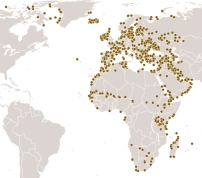
The Convention on Wetlands (Ramsar Convention), World Heritage Convention (WHC) and Man and the Biosphere Programme can give site networks more international coherence within the wider landscape/seascape. Each incorporates a process to review the status of protected areas and to identify those that are threatened or dysfunctional. Likewise, for the Convention on Migratory Species (CMS) and the Agreement on the Conservation of African-Eurasian Migratory Waterbirds (AEWA), networks of protected areas are seen as pivotal to the effective conservation of migratory species. Despite these conventions, nearly 900 sites of global importance for migratory waterbirds remain unprotected within the AEWA region.

Ecological networks of protected areas, that cross country boundaries, are needed urgently if the rate of biodiversity loss is to be significantly reduced (World Summit on Sustainable Development 2002). At the global level, the Convention on Wetlands (Ramsar Convention), World Heritage Convention (WHC) and Man and the Biosphere Programme all emphasize this concept and can give site networks more international coherence within the wider landscape/seascape. Each of these systems incorporates a process to review the status of protected areas and to identify those that are threatened or dysfunctional. Because such judgements are internationally agreed, nations are more likely to co-operate in helping to alleviate the problems. Likewise, for the Convention on Migratory Species (CMS), networks of protected areas are seen as pivotal to the effective conservation of migratory species.
The Agreement on the Conservation of African-Eurasian Migratory Waterbirds (AEWA) is the largest multilateral Agreement concluded under the CMS so far. AEWA aims to conserve 235 species of migratory waterbird that use some of the world’s major flyways, spanning 117 countries in Africa, Europe, the Middle East and parts of Asia and Canada. There are at least 2,252 Important Bird Areas (IBAs) within the AEWA area that support globally significant numbers of one or more of the AEWA-listed species (analysis of data held in BirdLife’s World Bird Database 2004). Nearly 40% of these sites are currently lacking either statutory protection at the national level or international recognition as Ramsar Sites, natural World Heritage Sites or Biosphere Reserves (see figure). The Wings Over Wetlands (WOW) project aims to support the implementation of AEWA by identifying networks of critical sites for migratory waterbirds within the AEWA area and seeking to fill gaps to improve the coherence of these site networks.
Related Case Studies in other sections
Links
References
Compiled: 2004 Last updated: 2008
Recommended Citation:
BirdLife International (2008)
International agreements can be used to make transboundary ecological networks a reality .
Downloaded from https://datazone.birdlife.org/sowb/casestudy/international-agreements-can-be-used-to-make-transboundary-ecological-networks-a-reality- on 01/02/2025